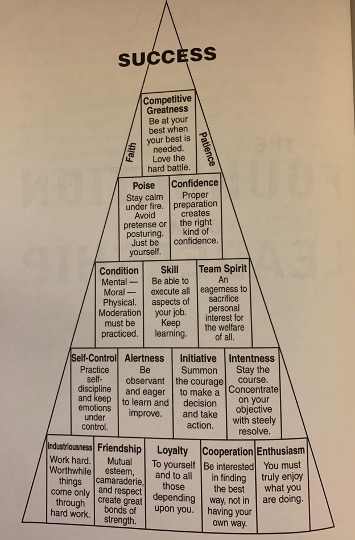I was a huge fan of former UCLA head men’s basketball coach John Wooden growing up, and I read everything I could about him as a teenager.
I played a range of sports and although I certainly enjoyed them, to me, sports were not just fun and games. Instead, I bought in to the idea that sports were a way of building character, or at the very least they revealed your character when you played them.
I made most of my lifelong friends on the courts and fields of the Northern California suburb I grew up in, and it would not be a stretch to say that I became friends with them in part because I got to know who they really were by the way they played the games we played, and the way they carried themselves as athletes.
So, Wooden’s perspective on what scholars call “character education” is what spoke to me most.
In a 2002 interview, Wooden said, “Everyone is a teacher. Everyone. Maybe it’s your children, maybe it’s a neighbor, maybe it’s someone under your supervision in some other way. In one way or another, you’re teaching them by your actions.”
That quote has always stuck with me.
Wooden focused his attention on “character” and respect, saying:
“I sought character in players, rather than players who were characters. For me, a good explanation of character is simple: respect for yourself, respect for others, respect for the game, whether it’s basketball, business or anything else.”
He prized players who had the right attitude and proper conduct.
He said, “Be a gentleman and do nothing that will bring discredit to you or your school – on or off the floor, when at home or away.”
He emphasized the importance of being what he called a “team man” who took pride in his work offensively and defensively.
He encouraged his players to keep learning every day and to study the mental side of the game.
Clearly Wooden was focused on the mental as well as physical toughness it takes to become a champion.
Did you know that Wooden’s ideas about character are now echoed in business schools?
Warren Bennis, founding chairman of The Leadership Institute and USC professor, once said:
“Successful leadership is not about being tough or soft, sensitive or assertive, but about a set of attributes. First and foremost, it is about character.”
For Wooden, character was tough to coach, so he turned away good players that he believed didn’t already have it.
He told parents that if their child didn’t already have it, he would not take them on as “reclamation projects.” He said, “While you, the leader, can teach many things, character is not taught easily to adults who arrive at your desk lacking it….be careful about taking on reclamation projects regardless of the talent they may possess.”
Can you teach character?
If so, why, and how?
If not, why not?
If not, what can you teach?
Discipline? Professionalism? Responsibility? Punctuality? Honesty? Other?
These are some of the questions I wonder about as I coach leaders to be the best version of themselves.
One thing I like to do with coaching clients is play a leadership game that is inspired by Wooden. Wooden had developed a handy visual representation of his values to share with players, fans, and other admirers, many of whom hailed from the business community.
You can do it here, too, by taking a moment to study Wooden’s “Pyramid of Success”, which offers a framework of specific behaviors required for achieving personal satisfaction. It includes 15 building blocks, organized into 5 interconnected levels. The first level is foundational and includes what Wooden refers to as the “cornerstone traits”. These include Industriousness and Enthusiasm. Each level builds on the next, culminating at the top level: Competitive Greatness. Flanking coach Wooden’s Pyramid of Success are important words such as Honesty, Integrity and Ambition, meant to hold the pyramid together.

The Wooden Pyramid of Success appears simple, but it’s the culmination of more than a dozen years of careful observation of human achievement, strength, and weakness. His rules for living are simple, but they require attention, consistency and commitment.
The question I have for all leaders who work with me is, What would you put on your pyramid? What would be your cornerstones? What would go at the top?
